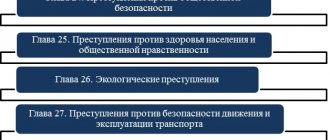Concept of crimes against property
The generic object in such acts are relations associated with the powers to own, dispose and use one or another property. Some property crimes are considered multi-objective. Subjects encroach not only on the main element, but also on the optional or additional element. For example, in a robbery, such an object is human health. Property crime targets property. It represents material objects into the creation of which human labor is invested. According to the norms of the Civil Code, they are subjects of property rights. However, not all of them can become the object of attacks by the category in question. For example, illegal cutting of trees cannot be considered a crime against property. Encroachments on objects in a natural state (wild animals, forests, fisheries, etc.) are considered acts in the environmental sphere.
Intellectual property is also not the subject of the crimes in question. In this case, attackers are encroaching on constitutional freedoms and human and civil rights. The subject of property crimes is usually movable material objects (cars, for example). However, encroachment can also be directed at real estate. A crime can be committed in relation to objects that themselves are evidence of values. Such objects include, for example, cash, bonds, shares, privatization checks and other securities. The subject of crimes is often the property right itself. For such an act to take place, the property must be foreign to the subject. The material assets that are being violated must belong to other persons by right of ownership or legal possession.
Theft in the property crime system
Before proceeding to the analysis of the composition of theft, it seems necessary to reveal the concept of theft as a generic category in relation to theft.
Essentially, the concept of theft is given in Note 1 to Art. 158 of the Criminal Code of the Russian Federation. Theft is understood as the illegal gratuitous seizure and (or) conversion of someone else's property for the benefit of the perpetrator or other persons, committed for selfish purposes, causing damage to the owner or other holder of this property.
The concept of theft in Note 1 of Article 158 of the Criminal Code of the Russian Federation contains generic signs of theft inherent in all its forms. In the theory of criminal law and in legislation, it is customary to identify general signs of theft1:
this action is in the form of seizure and (or) recourse in favor of the offender or other persons;
theft is unlawful and gratuitous;
theft always causes damage to the owner or other legal owner;
theft is committed for selfish purposes.
Types of theft mainly differ in the objective side of the crime, in the method of encroachment on someone else's property. The current criminal legislation of the Russian Federation distinguishes the following types of theft: theft (Article 158), fraud (Article 159), embezzlement or
In addition, it should be noted that, along with the concept of “theft,” the doctrine of Russian criminal law used the concept of “abduction,” which covered only certain types of theft and was correlated with the concept of theft as a part of the whole. Thus, Professor V.A. Vladimirov, characterizing the concept of kidnapping, wrote: “The defining feature of kidnapping is the seizure by the thief of someone else’s property from someone else’s possession, where seizure means the unlawful seizure of property, its removal from the owner’s possession, carried out against or against his will.”
The current Criminal Code of the Russian Federation of May 24, 1996 defined theft as the secret theft of someone else's property. In recent years, Article 158 of the 1996 Criminal Code of the Russian Federation has been significantly reformed.
Theft is understood as the illegal gratuitous seizure and (or) conversion of someone else's property for the benefit of the perpetrator or other persons, committed for selfish purposes, causing damage to the owner or other holder of this property. Theft is characterized by 4 signs that are mandatory and the absence of at least one of them allows the act to be considered not as theft, but as another crime, or an act not related to criminal law.
The specificity of theft is characterized by a secret method of activity, which allows us to consider theft the least dangerous of all forms of theft. We can conclude that secrecy is assessed based on objective and subjective criteria. The decisive criterion for establishing secrecy is the subjective criterion - the perception of the perpetrator that the property is being confiscated by him unnoticed[4].
Article 158 “Theft” establishes sanctions for attacks on material assets legally owned by citizens. This standard contains several parts. In Art. 158 part 1 of the Criminal Code of the Russian Federation reveals the main composition. The remaining parts contain qualifying characteristics. In accordance with them, the sanctions established in the first part are tightened. Let us consider further in detail Art. 158 part 1 of the Criminal Code of the Russian Federation. Article 158 Part 1 Characteristics of the act Part of the first specified norm contains the definition of “theft”. The Criminal Code comprehensively reveals its essence. It is worth noting that not all countries have an interpretation of this or that act in their legislation. However, in Russia the norms are structured so that a person not only knows that there is responsibility for illegal acts. Citizens must understand for what crime and what sanction is assigned. The act in question is the secret theft of someone else's property.
The legislation in this formulation indicates the mandatory elements of the crime. First of all, you should pay attention to the first word - secret. The theft of someone else's property within the framework of the norm under consideration is carried out hidden from the legal owner. That is, the owner of material assets does not suspect that he has lost something. Another mandatory feature is that the item must not belong to the criminal under any rights. Article 158 “Theft” is applied in cases where the subject has committed a gratuitous unlawful seizure of an item for personal gain. The norm also applies to cases of transfer of material assets in favor of an attacker or other persons, if as a result of this the owner or other possessor suffered damage. These acts form the corpus delicti of theft.
An act for which sanctions are established by Art. 158 part 1, is always an encroachment on a specific thing. It must refer to objects of the material world that have consumer value. These include money and documents used as their equivalents. At the same time, Art. 158 part 1 applies to encroachments on both movable and immovable objects, as well as those withdrawn from circulation. Article 158 theft Exceptions Documents that do not have a property nature and also do not have consumer value, but which provide the opportunity to receive money from them, cannot be the subject of theft. The latter, in particular, include checks, luggage receipts, passbooks, invoices, etc. Exceptions also include items that provide the right to receive other material assets. For example, these are wardrobe numbers, debit/credit cards, electronic keys to safes, vaults, etc. The results of intellectual work, electricity and heat cannot be the subject of theft.
On the illegality of the act provided for in Art. 158 part 1, says it was committed in violation of current regulations. Gratuitous is the appropriation of a thing without compensation for its use value. Seizure is a real action expressed in the direct movement of an object in the material world from the rightful owner to the perpetrator or other entities. Appeal in favor of an attacker or other persons is an action expressed in the illegal execution of documentation on the transfer of rights from the owner to a criminal and other improper citizens. It is worth saying that theft can be expressed in creating obstacles for the rightful owner to use/dispose of property. Wrongful seizure always occurs against the will of the owner. secret theft of someone else's property
If property is confiscated even in the event of a clear violation of the norms by a person who has an actual or alleged right to it, then it does not constitute theft. For example, the accountant withheld the amount of his earnings from accountable funds. Actions related to the removal of material assets from storage do not fall under this rule if they remained in the fund of their owner or the funds from their sale were used to satisfy the needs of the owner. In these cases, the subject may be held accountable for arbitrariness or abuse of power. Temporary use of material assets for personal purposes, if the objects are not disposed of, also does not constitute a crime. If there are appropriate grounds, such actions are qualified according to norms 165 and 166.
The direct object of theft is social relations that protect the property of a specific person (private, state, municipal and other types), which has been criminally encroached upon. The subject of theft can be any property, both movable and immovable, but only someone else’s, i.e. not in the property or legal possession of the perpetrator.
The elements of theft by their design are material and contain 3 main elements: the act, the consequences and the cause-and-effect relationship between them. The act is characterized by seizure, which is understood as the unlawful gratuitous extraction (exclusion, removal, allocation) of property from the possession (funds) of the owner with its simultaneous transfer to the actual illegal possession of the thief or other persons. Consequences are characterized by causing damage to the owner or other owner of the property. Significant damage is determined taking into account the property status of the victim, but cannot be less than two thousand five hundred rubles. Significant damage to a legal entity is determined each time taking into account its financial situation. It seems necessary to develop a criterion for assessing the infliction of significant damage to a legal entity. The theft is considered completed from the moment the consequences occur in the form of causing damage to the owner or other legal owner of the property and the perpetrator has the opportunity to dispose of the stolen property at his own discretion[5].
Theft is one of those acts that consists of the direct illegal taking of someone else's property, committed for selfish motives and for the purpose of unjust enrichment at the expense of this property, and without the subjects using their official position, and is not associated with a violation of economic ties and relations in the economic sphere .
When a theft is committed by a group of persons by prior conspiracy, it is characterized by the presence of two or more persons who can be recognized as the subjects of the theft, a preliminary conspiracy between them, and the joint commission of this crime. Theft committed by an organized group presupposes the presence of a stable group consisting of two or more persons united by intent to commit one or more crimes. A stable group is characterized, as a rule, by a high level of organization, planning and careful preparation of the crime, distribution of roles between accomplices, and so on.
Theft can be distinguished from fraud by method. Unlike a thief, who hopes that his actions will go unnoticed, the fraudster bets that, under the influence of deception or breach of trust, the victim himself will transfer his property to him. Theft can be distinguished from embezzlement and embezzlement by the subject of the crime. In case of misappropriation and embezzlement, the subject is a special one, that is, the person to whom the property was legally entrusted. We can conclude that the main defining feature of robbery, distinguishing it from theft, is the method of committing the crime, that is, the open nature of the actions of the perpetrator, or (which is the same) the absence of a sign of secrecy. Sometimes the problem arises of distinguishing between theft and deliberate destruction or damage to property. For example, destruction of property may be a way of disposing of stolen property, which requires qualification only under Article 158 of the Criminal Code (if the culprit destroys stolen property that he cannot use). The distinction is made on the objective and subjective side of crimes. Depending on the categories of crime, theft is classified by the legislator as a crime of minor gravity (part 1 of article 158), moderate gravity (part 2 of article 158) and serious crime (parts 3, 4 of article 158).
Features of the composition
By their design, the crimes under consideration are predominantly material. This means that the legislation connects the moment of completion of an act with the occurrence of certain consequences. In particular, we are talking about causing property damage to the owner. A crime against property may have a formal element. Such acts, for example, include robbery (Article 162), unlawful taking of a vehicle without the purpose of theft (Article 166), extortion (Article 163). If a crime against property has a material structure, it is necessary to establish a connection between the behavior of the perpetrator and the consequences that occurred as a result of his act. An optional feature is the method of committing illegal actions. It is considered a constructive element of all types of theft. At the same time, this feature is a delimiting criterion. Thus, in the case of theft, a secret method takes place; in fraud, deception and abuse of trust are used.
Criminal legal characteristics of the crime provided for in Art. 158 of the Criminal Code of the Russian Federation
When considering any crime, it is necessary to analyze its subjective and objective characteristics. The correct definition and description of the elements of theft helps to understand: did the person really commit a secret theft or are we talking about another crime? Therefore, we will consider in detail each element of theft.
An object
Correctly identifying the object of a crime allows not only to determine whether the committed act is criminal, but also to distinguish one crime from another , that is, to correctly qualify the committed actions of a person.
Important! The object of the crime is the interests, benefits and social relations protected by the state from the criminal encroachment of other persons.
Article 158 of the Criminal Code of the Russian Federation is located in Chapter 21, which is devoted to crimes against property. Therefore, the main direct object is property relations.
If a person commits theft with qualifying characteristics, then he encroaches not only on property relations, but also on additional objects. Thus, when committing a theft with illegal entry into a residential premises, the object is the social relations that arise in connection with the implementation of the constitutional right to the inviolability of the home (Article 25 of the Constitution of the Russian Federation).
Item
When committing theft, the item is a mandatory element , since in the Note to Art. 158 of the Criminal Code of the Russian Federation states that the subject of any theft, including secret theft, is only someone else’s property.
Such property must have the following characteristics:
- Physical sign.
Property must have material characteristics, that is, it must be tangible and can be touched. In other words, property in the context of the subject of theft is understood as bodily things.
However, in 2021, a new special qualifying feature was introduced - paragraph “g” of Part 3 of Art. 158 of the Criminal Code of the Russian Federation, so now electronic money can also be the subject.
- Legal sign.
The property must be alien to the guilty person, that is, not legally owned by him. If Peter takes away the TV set from his wife, which they bought together during marriage, then we cannot talk about the presence of the sign of “someone else’s property.” In this case, actions can be regarded as arbitrariness (if there are signs).
- Economic sign.
The property must have some value, which is expressed in the value of the stolen property.
Subject
Any person can commit theft, but in order for such a person to become the subject of a crime, he must have the characteristics established in the Criminal Code of the Russian Federation. The subject of the theft has the following characteristics:
- Sanity.
At the time of committing the theft, the person must be aware of what exactly he is doing, and also must not have mental disorders that indicate that he is insane.
- Age.
According to Part 2 of Art. 20 of the Criminal Code of the Russian Federation, a person is subject to criminal liability for theft from the age of 14.
Recommended reading:
Commentary of the Supreme Court PP to Art. 158 of the Criminal Code of the Russian Federation (Theft)
Dimensions of theft
Complicity in committing theft
Objective side
According to the design of the objective side, theft refers to the material composition, therefore the objective side of theft includes the following mandatory elements:
- Act.
From the point of view of criminal law, an act can be expressed either in action or inaction. Note to Art. 158 of the Criminal Code of the Russian Federation directly states that theft can only be expressed in an active action, because it is difficult to imagine the seizure or circulation of property committed through inaction. It is important that theft is characterized by secret, illegal and gratuitous actions.
Reference.
The action can be expressed in withdrawal and/or circulation. Seizure is expressed in the fact that the perpetrator takes property from the victim without his consent, that is, the thing is removed from “dominion” (possession).
The treatment is that a person gets the opportunity to use the property as if it were his own, including disposing of it. At the same time, it is necessary that both the seizure and the treatment be permanent and not temporary.
So, if Ivan gets into a parked car to ride in it and then return it to the owner, then we cannot talk about theft. His actions will be qualified as hijacking under Art. 166 of the Criminal Code of the Russian Federation.
- Socially dangerous consequence.
Since the legislator defines the elements of theft as material, the consequence in the form of causing property damage is a necessary element. Such damage is often expressed in the loss of property and can be caused not only to the owner of the property, but also to another owner.
For example, if Peter rents a car, and Ivan kidnaps it. Of course, we are talking about causing property damage to the tenant.
- Causal relationship.
A cause-and-effect relationship between an action and the consequences that occur. It is necessary that it was the person’s actions that led to the property being confiscated and causing damage to the owner.
Subjective side
The subjective side is a certain reflection of the objective side of the crime committed in the mind of the person, that is, the attitude of the perpetrator to the theft committed. Mandatory elements of the subjective side of theft are:
- Direct intent.
Theft is the theft of property committed secretly. When committing secret theft, the perpetrator must be aware that he is secretly taking someone else's property, and understand that he is causing damage to the owner, as well as desire it.
- Selfish goal.
A person commits theft in order to obtain some property benefit either for himself or for others. Acting for selfish purposes, a person seeks to enrich himself and profit from stolen property.
Important! The motive is not a mandatory element of the subjective side of theft, so it can be anything (envy, revenge, risk, etc.). The goal is the final result that the guilty person seeks to achieve, and the motive is a certain reason for which he commits a crime.
For example, Ivan, acting deliberately, steals a mobile phone from Peter’s pocket in order to later sell it and donate it to charity.
In the example given, the goal is the desire to get money (self-interest), and the motive is altruism, since he commits theft to help others.
Subjective part
All attacks on property, except for careless destruction or damage to property, are carried out intentionally. As a rule, the subject's intent is direct. The subjective side of such damage/destruction of material assets, which additionally resulted in the death of a person or other serious consequences, is characterized by guilt in two forms. For some attacks, a prerequisite is the presence of a selfish goal. For example, it is present in all types of theft.
Subjects
Sane citizens who have reached the age established by law can be held accountable. For committing theft, extortion, robbery, robbery, as well as unlawful taking of a vehicle without the purpose of stealing or intentional damage/destruction of other people's material assets under aggravating circumstances, punishment is applied to persons over 14 years of age. For other property crimes, the age of prosecution is 16 years old. A number of compositions provide for a special subject. Thus, in case of misappropriation or embezzlement, the citizen who is entrusted with the property for storage will be held accountable.






